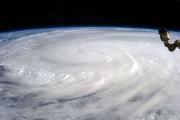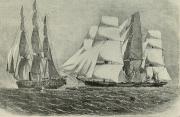Radio Program
Our regular Science and the SeaTM radio program presents marine science topics in an engaging two-minute story format. Our script writers gather ideas for the radio program from the University of Texas Marine Science Institute's researchers and from our very popular college class, Introduction to Oceanography, which we teach to hundreds of non-science majors at The University of Texas at Austin every year. Our radio programs are distributed at to commercial and public radio stations across the country.
The most powerful tropical cyclone ever recorded slammed into the Philippines in November of 2013. Typhoon Haiyan packed sustained winds of 195 miles per hour — the strongest of any typhoon or hurricane ever recorded at landfall. Over a few days, as it roared across the islands and then into mainland Asia, it killed as many as 7500 people and caused billions of dollars in damages.
As science-fiction writers often remind us, life on Earth is based on carbon. The element is found in everything from proteins and carbohydrates to DNA — everything that makes it possible for life to move, eat, and reproduce.
Yet carbon isn’t something that we ingest directly — you can’t order a plate of charcoal at your favorite food trailer. Instead, carbon comes to us through plants and tiny plant-like organisms in the oceans, which get it from carbon dioxide in the atmosphere.
Atlantic cod was a mainstay of the New England economy for centuries. Commercial fleets brought in tens of thousands of tons of the tasty fish every year. A carved wooden cod was even placed in the Massachusetts House of Representatives.
But overfishing led to a collapse of the industry in the 1990s. And there’s been little rebound since then, despite stricter limits on annual catches. A recent study says that, in at least one region, that may be the result of warmer waters.
In “The Rime of the Ancient Mariner,” English poet Samuel Taylor Coleridge chronicles the adventures and misfortunes of a sailing vessel. Among the challenges was a time when the winds died, leaving the ship motionless, which the mariner describes like this:
Day after day, day after day,
We stuck, nor breath nor motion;
As idle as a painted ship
Upon a painted ocean.
The ship was stuck in the doldrums, a zone near the equator with little wind but frequent clouds and storms.
When an imperial shrimp wants to get from one spot to another, it doesn’t hail a cab or an Uber — and it certainly doesn’t walk. Instead, it may catch a ride on the nearest sea slug or sea cucumber. And as payment, it tidies things up a bit.
Despite its regal-sounding name, the imperial shrimp is tiny — less than an inch long. It’s found in shallow waters in the Indian Ocean and in the Pacific from Hawaii to Asia.
If you stand near the water’s edge on a breezy day, when the waves are breaking on shore, you can feel the sea spray — a mixture of water, salt, and microscopic organisms. While much of the spray falls back to the surface, some of it is swept high into the sky. There, it can help form clouds — playing a role in the weather, and in the long-term climate.
One of the joys of an afternoon at the beach is watching the seabirds as they soar with the winds. But such bird watching might serve as more than just entertainment. A recent study found that tracking seabirds as they fly along the coastline can reveal the speed and direction of the wind — important details for weather forecasts and climate models.
If you look at a map of Australia, it looks like a giant has taken a bite out of its southern flank. A gentle indentation curves across almost the entire continent. And coincidentally enough, it’s known as the Great Australian Bight. In this case, though, “bight” is spelled B-I-G-H-T. The name comes from a nautical term for a curved section of rope or string. Similar “bights” are found around the world, including the Atlantic and Pacific coasts of the United States.
If you could measure the total weight of each kind of animal on the planet, the winner wouldn’t be people or elephants or even blue whales. Instead, it probably would be one of the smallest creatures on the planet: Antarctic krill. The shrimp-like critters typically reach about two inches in length and weigh a few grams. Yet there are so many of them that their total weight could add up to 500 million tons.
A sperm whale can dive thousands of feet deep to catch its fill of squid. The pressure causes its rib cage to buckle inward and its lungs to collapse. Yet the whale survives just fine because that’s what’s supposed to happen. Not so with people, though. Depths of a hundred feet can cause problems, and anything below a few hundred feet is fatal.
The pressure is caused by the weight of the water above. Every 33 feet in depth adds the equivalent of the pressure of the atmosphere at sea level — 14 and a half pounds per square inch.












